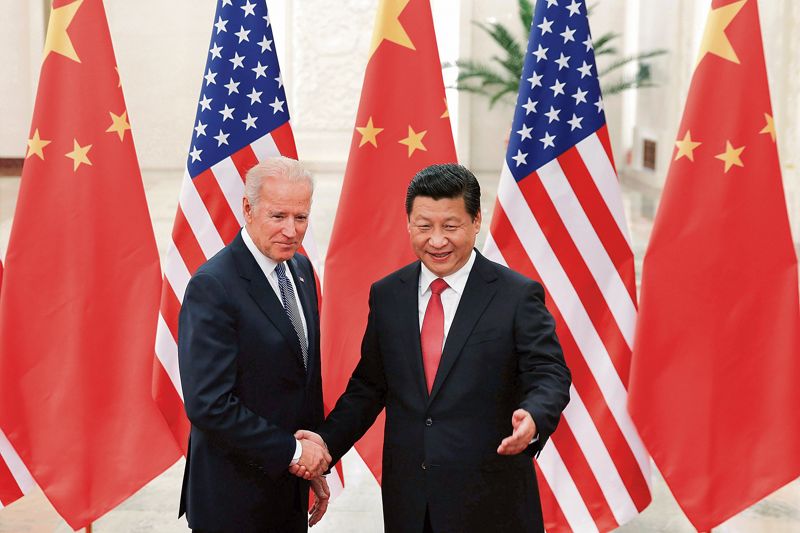China’s Nuclear Build-up: Implications for India
ORCA
APLN member Manpreet Sethi reflects on China’s refocus towards increased nuclear numbers. She examines the reasons why China has become active in its nuclear build-up, analyses some of the Chinese explanations and offers some suggestions for India’s responses. Read the original article here.
China’s nuclear build-up is much in news. The November 2022 annual report on Military and Security Developments related to the People’s Republic of China, released by the US Defence Department has raised its own estimates from last year on the likely increase in China’s nuclear warheads. Last year it had claimed that China may have 1000 nuclear weapons by 2030; the latest report has raised them to 1500 by 2035. Much of these guesstimates are being premised on the discoveries made through commercial satellite imagery showing new silos were being constructed at three sites in China and the increasing number of dual use capable missiles in Chinese inventory.
Traditionally, American official estimates of China’s nuclear numbers have been found to be inflated. Since Beijing maintains silence, neither confirming nor denying the discoveries or figures, there is no way of determining whether it wishes to, or will reach, the American figures. However, there is little doubt that there is an accelerated activity around China’s nuclear capabilities. What could be the possible reasons for this? How should India understand these developments? What kinds of responses do these merit? In order to answer these questions, this article examines the reasons why China has become active in its nuclear build-up, analyses some of the Chinese explanations and offers some suggestions for India’s responses.
Possible Reasons for Nuclear Build-up
The sudden increase in Chinese nuclear arsenal is a new development given that the nuclear numbers had remained roughly stagnant around 250-270 for some decades. But, during this period too, China was nonetheless busy enhancing the reliability, range, accuracy, mobility, penetrability and overall survivability of its delivery systems. So, the capability build-up had been targeted at other technological advancements. Once China announced the deployment of MIRVed missiles capable of carrying 3-10 nuclear warheads, a concomitant increase in numbers was expected. However, news about construction of hundreds of silos seems to exceed this requirement. What is the purpose of this?
Many motives can be surmised. Even as all of them have to do with the Chinese perception of the US, two reasons stand out: one is related to its security concerns while the second to a belief that a bigger arsenal will fetch it better respect from Washington.
Security-related Reasons for Increase
Enhancing survivability can be counted amongst the most important objectives of this exercise. In what may be a shell game, the silos can be seen as part of a deception strategy to complicate the aggressor’s targeting plans, forcing him to waste his warheads on silos that may or may not contain any missiles. The silos under construction are believed to be for housing more DF-41s. The signal to the US therefrom is that it cannot be confident of carrying out a disarming first strike against China. This need may have been felt after the US abandonment of the INF treaty, which allowed it to build and deploy missiles in intermediate ranges closer to China, including on SSBNs positioned in the Pacific. Given China’s extreme sensitivity to a ‘Taiwan contingency’, especially in wake of the Russia-Ukraine conflict, China could have felt the need to enhance its deterrence by increasing the number of its own ICBMs. Another reason could be that silos enable a higher state of operational readiness by allowing the targeting coordinates to be pre-fed.
US BMD along with a focus on conventional global prompt strike (CGPS), including the development of conventional hypersonic missiles that can potentially destroy Chinese nuclear assets, have been perceived by China to erode its ability to cause unacceptable damage after taking a first strike. Therefore, silos, besides mobility of missiles, are being used to signal better survivability of the retaliatory capability.
Status-related Reasons for Increase
China’s nuclear expansion is also likely a piece in its aspiration for great power status. In an apparent desire to ‘beat’ the US on every parameter, Beijing has felt the need to do so on nuclear stockpiles too. Xi Jinping himself has designated PLA Rocket Force (PLARF) as “the strategic support for the country’s status as a major power”. [1]
A Chinese scholar, Dr Tong Zhao, too has linked the silos to “bolster China’s image as a much stronger nuclear power than before. Whether China will actually fill each silo with an ICBM is a different matter…” But, as he suggests, the “bigger arsenal would make the country’s rivals respect China and exercise more self-restraint when dealing with Beijing.”
Indeed, nuclear weapons appear to have become central to China’s national security and international status. To recall, in his address to the 19th Party Congress, Xi Jinping identified three duties for the newly reorganised PLA Rocket Force (PLARF), which has also been elevated to the position of the fourth arm of the military alongside the army, navy and the air force. He exhorted it to act as the “core strength of China’s strategic deterrence, the strategic support for the country’s status as a major power, and an important cornerstone safeguarding national security”.
The US has instinctively dubbed this as potentially destabilising since it could make China’s posture and strategy more “coercive” and able to “execute any plausible employment strategy”. US military leaders have, therefore, demanded a reciprocal increase in US capabilities. Adm Charles Richard, Commander of US STRATCOM, in a speech to the space and missile symposium on Aug 23, 2021, drew attention to the unprecedented “three-party dynamics” that had emerged with Russia and China both having become near peers.
While US assessment has its own logic, including its tendency to see nuclear weapons as war-fighting instruments, it is not sure whether that is the Chinese aim. An analysis of writings by Chinese scholars on this subject yields mixed results. While some have linked it to increasing operational readiness with silo-based missiles, others have dismissed silos as an obsolete technology that is far less preferential to mobile missiles. Beyond scholars, media strategists like Hu Xijin, the editor in chief of Global Times, dispute the very claims of increase being made by US think tanks. He espies in this effort an objective to put pressure on China and to “wage a war of public opinion”; the push of such a narrative in state media is telling of the narrative the Communist Party is keen on advocating vis-à-vis its nuclear programs.
China’s Developments from India’s Perspective
The nuclear modernisation underway in China may be surprising in its pace and scale of development, but it is not new. There has been continued development and deployment of road and rail mobile, solid-fuel missiles, improvements in H-6N nuclear-capable aircraft and the SSBNs now equipped with longer range and more accurate JL-3 SLBMs. Accuracy of medium range missiles, such as the DF 26, which is designated as a dual capable missile, has also been improving over years. This is a more worrisome dimension from India’s perspective than the newly discovered ICBM silos.
Even as it can be argued that most Chinese nuclear developments are triggered by a US threat perception, India is nevertheless an affected party. A bigger and better arsenal would obviously bring China the benefit of more kinds of employment strategies. It also may give it a better sense of escalation management. Nonetheless, the good news for India is that much of the confidence of managing nuclear escalation rests on assumptions (not empirical evidence) and can prove to be illusionary. In contrast, India considers these weapons of mass destruction as best suited for achieving deterrence through the threat of inflicting punishment. Therefore, its focus needs to be on building a capability that can promise delivery of nuclear ordnance to cause unacceptable damage to the adversary.
Such an approach then liberates India from a sense of panic to add to the warhead stockpile. Rather, attention remains on building robust and survivable second-strike forces to signal certainty of retaliation. For deterrence to work, even in face of a better equipped nuclear adversary, the ultimate requirement is the ability to signal inflicting punishment with even a few attacks on countervalue targets that would nullify the adversary’s assumed gains.
It is evident that China’s reasons for undertaking the expansion and upgradation of its nuclear forces ranges from its sense of insecurity vis-à-vis the US to its desire for ‘beating’ the existing great power. It is also flush with money and has invested lavishly in advancing its technological capabilities. It can afford this build-up. During the Cold War, the US had planned to race the Soviet arsenal to force the country’s economic downfall. The same may not apply to China. Rather, not only will China not easily go bankrupt, but the economic consequences of nuclear arms racing would be felt by Washington.
The best option for India is to stay away from such build-up spirals. It can neither afford this, nor is it necessary. In fact, India’s security challenges arise more from the probability of having to fight conventional wars given the kinds of threats posed by both its nuclear armed adversaries. Pakistan, on the one hand, regularly mounts cross-border terrorist attacks on India. China meanwhile has increased its salami slicing transgressions across the unresolved line of actual control.
India’s requirement in these circumstances is for a suitably equipped conventional military that can undertake surgical punitive strikes against Pakistan, while being able to hold off an aggressive China at the borders, besides being able to handle a possible two front war too. New Delhi must maintain a sharp focus on building the right kind of conventional military capability to match these threat perceptions.
Nuclear weapons are obviously not the answer for these kinds of threats. In fact, given their nature as instruments of mass destruction, the possibility of using them for credible military objectives is severely constrained. Hence, overspending on a capability of limited utility would be wasteful. Irrespective of Chinese increase in nuclear numbers, for India, the focus should be on steadily building and improving its second-strike capability. Credible and survivable retaliatory action is the best, and relatively the least expensive option, to pursue.
Endnotes:
[1] Xi Jinping, “Secure a Decisive Victory in Building a Moderately Prosperous Society in All Respects and Strive for the Great Success of Socialism with Chinese Characteristics for a New Era”, Speech delivered at the 19th Party Congress, Oct 2018.
Image: Xinhua




